The Digital Transformation Leaves No Industry Untouched
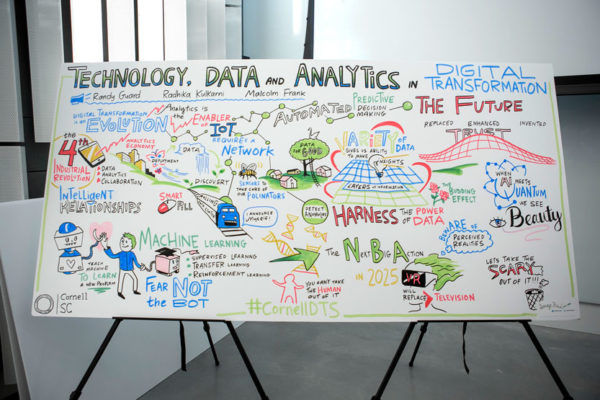
Business leaders discuss how their organizations are embracing digital change with the help of analytics and innovation at the inaugural Cornell SC Johnson College of Business Digital Transformation Summit.
Leaders from a myriad of industries gathered to discuss how digital technology has challenged and transformed their companies at the inaugural Digital Transformation Summit, hosted by the Cornell SC Johnson College of Business and held at the Cornell Tech campus on Roosevelt Island in New York City on Dec. 8. Cornell SC Johnson School of Business Dean Soumitra Dutta kicked off the event, noting that virtually every sector, from financial services to healthcare and education, has had to navigate changes brought about by digital technology. The summit’s first panel opened a day-long discussion of this topic as Harvard Business School Dean Nitin Nohria, TIAA CEO Roger Ferguson, and Cancer Treatment Centers of America (CTCA) CEO Raj Garg took the stage to share stories about how their respective organizations have embraced the digital age.
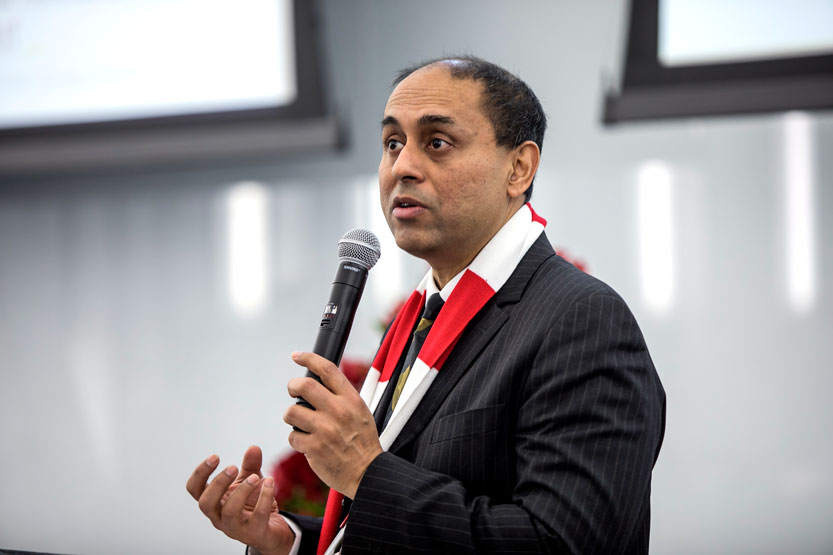
Because universities aren’t exactly traditional businesses, Nohria said, he never imagined that online technology would threaten the existing model of business education — but he has since realized he was wrong. As he sees it, digital disruption can go one of two ways: “Some organizations simply disappear. Look at the music industry. There are no record stores left anywhere. Others, like the retail industry, are pressured to evolve. Education,” he said, “will be like the latter.”
The education space has already evolved in a number of ways, Nohria pointed out. First, digital technology has provided students in remote areas of the world with access to courses and academic programs. It has also enabled education to be available on-demand and in real time and has made it easier to cater to different learning styles. To respond to these changes, Harvard Business School has created virtual classrooms to open its curriculum to students in distant corners of the world.
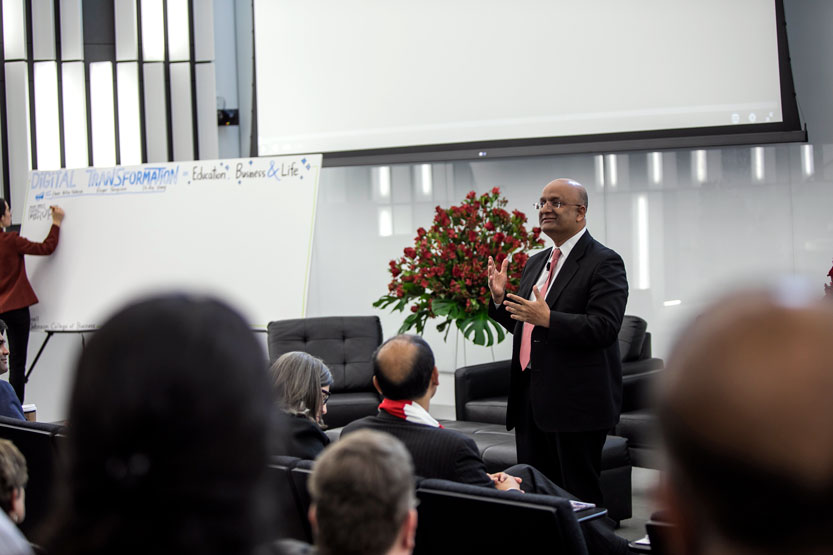
TIAA’s Ferguson addressed the transformation that the financial services sector has seen at the hands of digital technology. Many financial services players were late to evolve, hindered by “legacy systems, a tendency for risk aversion, and heavy regulations,” he explained. But with the rise of competitive, often mobile-first services like Venmo, PayPal, Apple Pay, and Google Wallet, paired with the “Uberization of the financial services environment,” in which consumers dictate when and how they transact, financial services veterans could no longer feign ignorance. They, too, were pressured to evolve.

TIAA, for one, has adapted to the changing landscape by upgrading its mobile experience, acquiring online bank EverBank to improve its own digital banking experience and creating a digitalization metric to measure its digital success. “Our transformation is still in its infancy, but we’re continuing to optimize by looking at metrics from our existing digital experiences,” Ferguson said.
A Spotlight on Healthcare
The healthcare industry took center stage at the summit, with several examples of how a sector plagued by notoriously bad customer experiences is reinventing itself thanks to digital innovation. CTCA’s Garg zeroed in on cancer, highlighting the complexity of the disease cycle, from diagnosis to treatment and remission, or sometimes, relapse. A cancer diagnosis is emotional, yet Garg says the healthcare industry does a poor job of delivering a patient experience that’s sensitive to the toll the disease takes on patients and their families.
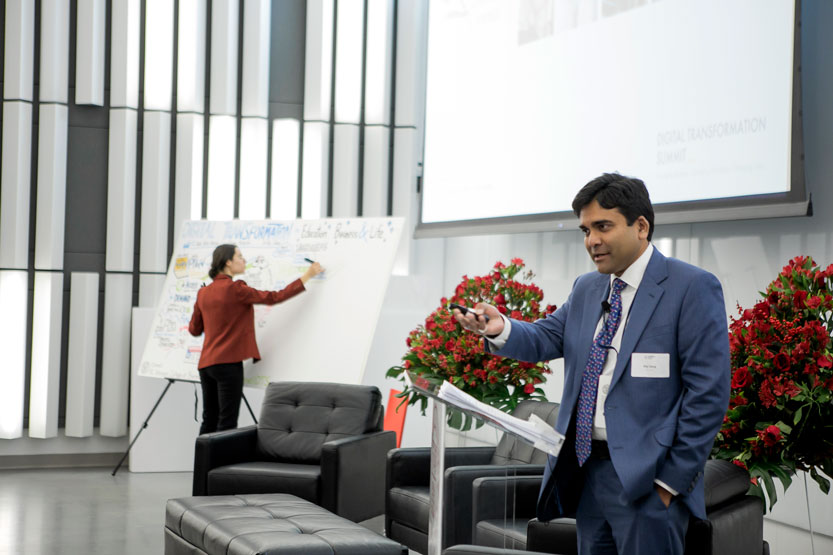
According to Garg, patients constantly tell him “about the callousness and lack of compassion they experience from the moment they learn that they have cancer.” Digital enablement, meanwhile, promises to change the status quo. CTCA, for example, has redesigned its website to eliminate friction for patients wherever possible, enabling them to focus on recovery, not bureaucracy. With a new patient portal, users can now self-schedule appointments, get faster access to test results, link their network of care providers, and connect to experts around the world.
In a separate fireside chat, Aetna CEO Mark Bertolini, MBA ’84, outlined how his company also is working to improve customer experience in healthcare by bringing digital resources to brick-and-mortar locations. The healthcare coverage provider recently partnered with CVS to create physical places where customers could get answers to insurance questions and be proactive about their health. The goal was to deliver an Apple Store Genius Bar-like experience, Bertolini explained, complete with resources in a centralized, digital hub. “The worst thing about insurance is how confusing it is. We tried to make apps to help customers handle different processes, but it wasn’t worthwhile,” he said. “We knew we had to create a sort of storefront system where everything was connected.”
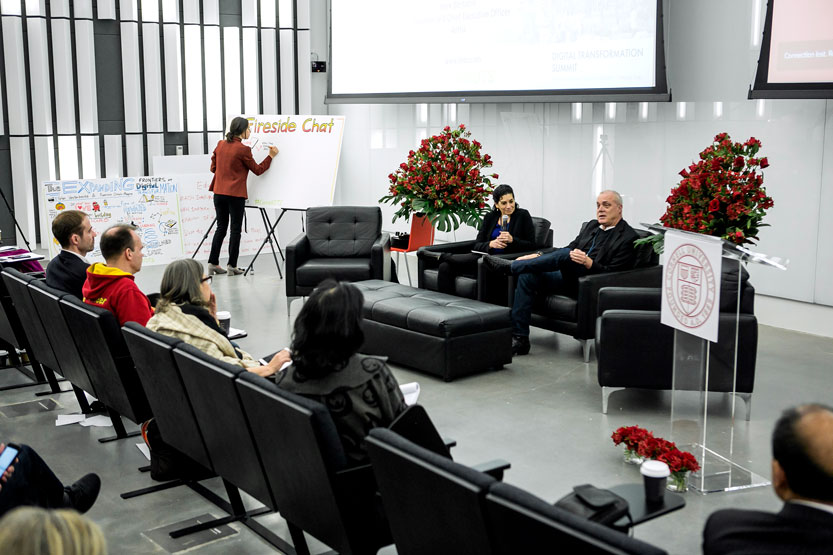
But the digital transformation is about more than just connectivity.
The Age of Data, Analytics, and Artificial Intelligence
Beneath the surface of digital technology lies a massive amount of data, and if data is the byproduct of digitalization, then analytics is what digests it. “We are in the analytics economy, and our value and acceptance of analytics drive and define it,” Randy Guard, CMO at analytics software provider SAS, explained during his session. “We accept the fact that analytics is part of our home. Machine learning and analytics make Google Home and Amazon Alexa work.” Data is behind all digital channels — computers, mobile devices, and yes, smart home devices powered by artificial intelligence.
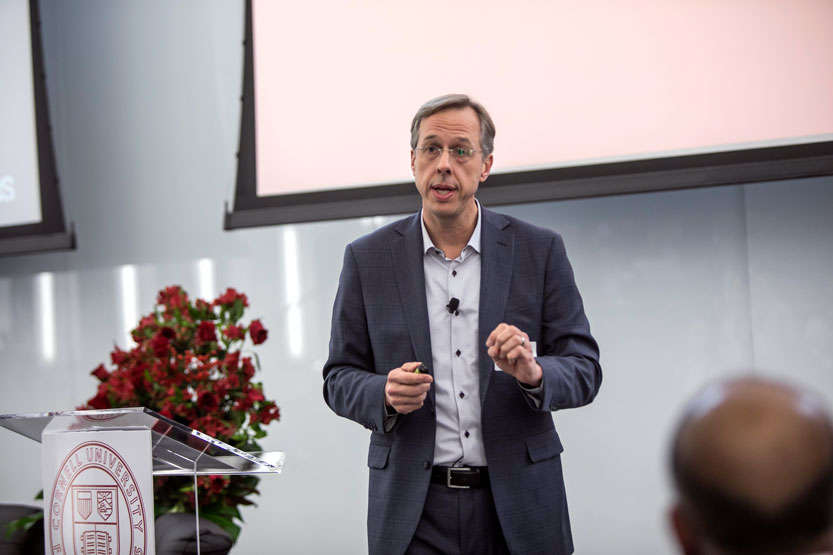
That’s why, to reach the full potential of their digital transformation, organizations not only have to make their businesses digital but also collect the right insights on customers’ behavior so they can keep iterating and improving the customer experience. In healthcare, for example, digitizing patients’ medical or genetic data serves a dual purpose: It simplifies access and streamlines how the information is stored, but it also opens the door to the application of machine-learning algorithms and predictive analytics, which can parse data to predict things like which drugs may or may not work for individual patients based on previous treatments or even specific genetic markers. “Three technological factors have come together to give rise to machine learning and artificial intelligence: the availability of data, the growth of computing power, and the birth of algorithms that allow us to make predictive insights,” said Radhika Kulkarni, vice president of advanced analytics research and development at SAS.

AI is Not a Threat — It’s an Opportunity
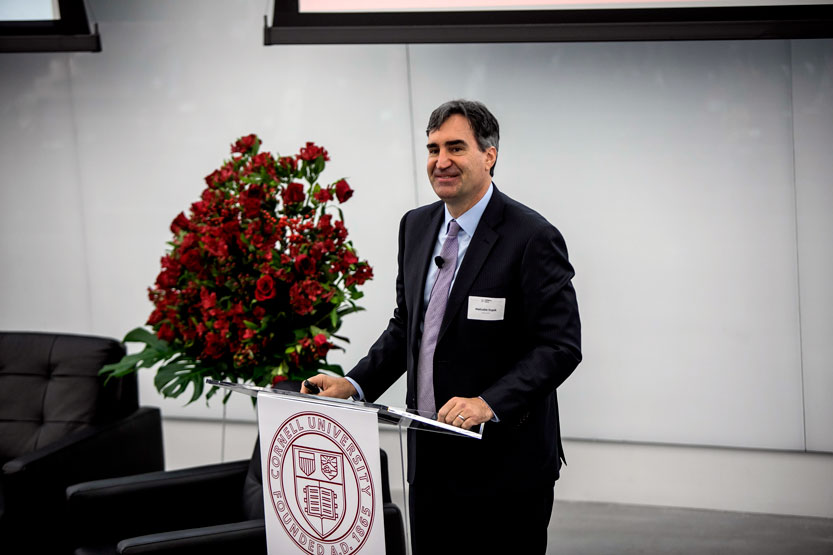
Even now that artificial intelligence is becoming increasingly mainstream, it’s still a scary concept for some. While most have set aside the comical portrayal of artificial intelligence as an army of self-aware robots, the threat that AI-powered technology will eliminate jobs remains real. But to “take a pessimistic view of AI is to ignore the arc of history,” Malcolm Frank, executive vice president at Cognizant, said during his session.
Eventually, Frank predicted, societies will look back to today and ask, “What was the big deal?” Though some pundits have predicted that AI will kill nearly half of jobs, Cognizant projects that only 12 percent of jobs will be eliminated, while 75 percent of jobs will be enhanced, leaving the remaining 13 percent to be made up of entirely new jobs and industries, largely due to the Budding Effect.
The Budding Effect, named after Edwin Budding, the inventor of the lawnmower, refers to a seemingly small invention or innovation that turn outs to have a much wider impact. In Budding’s case, his invention gave birth to the sports industry: Once it was possible to have evenly trimmed grass, it became easier to play tennis, rugby, and football, Frank explained. Bringing the day’s discussion full circle, Frank presented how the Budding Effect of AI will continue to transform the healthcare industry, among many others.
“Misdiagnosis is a huge problem, and it’s an area where AI could have a huge impact,” Frank said. “By 2025, genomic sequencing will surpass YouTube as the biggest data generator of our time. Applying predictive analytics and artificial intelligence algorithms to this wealth of data has the potential to completely change how patients are diagnosed and treated, and this is just one of the many massive implications of AI.”
What’s the Big Idea?

During a breakout session at the Digital Transformation Summit, attendees gathered to brainstorm new opportunities pertaining to one of three topics: business, education, and healthcare. Participants were asked to think of a big idea related to the topic assigned, share it with a partner, and, in three minutes, decide which of the two ideas was best. The pair then had to share their chosen idea with another duo nearby and decide which one of those was better, again in three minutes. Teams repeated this process several times, debating ideas and forming groups consisting of four, eight, and then 16 people. When there were only a few large groups left, each group shared its business concept with the entire room, at which point the best idea was chosen by applause.
In the room where business was the central topic, the resulting big ideas were a software solution that could demonstrate why corporations should focus not only on short-term profits, but also on investing in social good; literary kinetics software that could personalize the experience of reading a book; blockchain-based technology capable of certifying property rights in developing countries; and a virtual travel- and food-experience application that could recreate exotic fine dining at home.
Led by Dean Mark Nelson, the challenge ended with a four-way tie — so the verdict is still out. Which idea do you think deserves to win?
The Future Depends on Average Intelligence
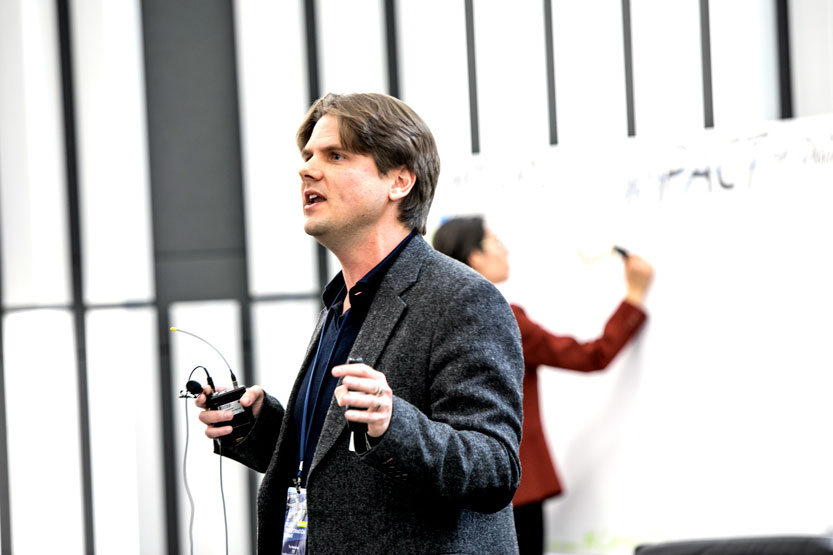
It’s tempting to assume that the greatest inventions come from the most brilliant minds, but in his presentation, “The Power of Average Intelligence in the Digital Age,” Tim Hentschel ’01 (Hotel), CEO of Hotelplanner.com, explained why most of the time, the best ideas are born out of practicality and necessity — not brilliance.
Historically, “average intelligence has driven innovation,” Hentschel said. Ancient Romans, for example, were always big proponents of sports. But when they came up with the concept of gladiator games, sports were elevated to a new level of viewership. Soon, massive arenas were filling with fans, and there was no way to manage entry. That is, until the ticket was invented.
Some modern businesses started out this way, too. Today, Best Western is one of the largest hotel chains in the world, but there was no secret formula to its growth. Hotels were simply set up as far apart from each other as a tank of gas could carry travelers, Hentschel revealed. Even tech giant Google was created around a basic idea — that searching the Web should be free. “The inventors of Google didn’t come up with an original idea,” Hentschel said. “Free is not innovative, but it did turn out to be brilliant.”
The takeaway for budding entrepreneurs? Don’t set out to be innovative. Identify an unfulfilled need, and innovation will follow.

